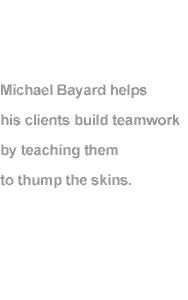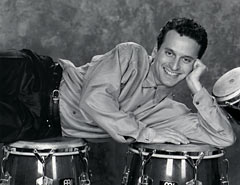 |
|
||||||||||||

|

|
|
By Nancy K. Austin
|
Michael Bayard, a seriously credentialed, classically trained percussionist, is on the phone, and he's describing what he does for a living. He seems concerned that I'm just not getting it. "Okay, now, listen to this," he says. Churra- The gourd story is a leitmotif in the composition of Bayard's career. It's what helped him bridge two worlds, from first-chair percussionist at concert performances with the Sacramento Symphony, to creator and director of educational and corporate teamwork programs. "When I do a little demo over the phone, it's like, this guy's kind of intense, you know? So I have to balance that with a logical description," Bayard says. "Because what am I going to do, play a vegetable gourd for 30 senior managers at Intel? I don't think so." Bayard's musical presentations resonate with professionals and pupils alike. His corporate programs fuse his flair for performance with leadership training, team-building, and motivation. Whether it's a big-time keynote appearance or an in-house workshop, Bayard's program is one part drum history, one part music lesson, and one part interactive performance. He turns buttoned-down meeting participants into a jazzy percussion ensemble, and all the time he's hammering away on the drums and drawing leadership parallels, spouting coaching tips, reminding everyone about human potential (the gourd returns), and enthusing about the power of harmony and shared rhythm. In Bayard's school programs, the structure and goals are pretty close to the grown-ups' version. He'll use a heartbeat to explain tempo, then demonstrate the sounds different percussion instruments make, then put together an ensemble to perform a short rhythmic phrase he's taught the kids. These educational special assemblies are always hugely popular events, for two reasons. Kids just adore learning about exotic instruments and the weird sounds they produce; it's captivating. And since music education is the first thing to go in budget-bludgeoned American schools, a program like Rhythm Magic is a feast the junior drummers can't get enough of. That's just fine with Bayard, who says his approach awakens students to music while helping them express themselves with a sense of purpose. You Can Take the Boy Out of Flushing... Bayard percussed his way out of his native Flushing, Queens, by learning to drum on a rubber practice pad in the basement of his parents' house. "They're both actors, and they ran this little community theater out of there. So I had a theatrical connection to music," he says. "And I was really into Pink Floyd. I loved how symphonic they were. It was a journey through the subconscious, listening to them. But more than anything else, I've always been interested in sound. The drama of sound."
At 15, Bayard was accepted on full scholarship to the Juilliard School, an institution that counts violinist Itzhak Perlman, opera singer Leontyne Price, and jazz trumpeter Wynton Marsalis among its graduates. From there, he continued his studies at Philadelphia's Curtis Institute of Music, one of the finest music conservatories in the world and one of the few granting full-tuition scholarships to all its blindingly gifted students. From Happy Meals to a Franchise of His Own Two weeks after graduating from Curtis, Bayard joined the Sacramento Symphony as principal percussionist, a post he would hold for the next 17 years until 1994, when he cut loose and went solo. It was a civil but inevitable parting. The symphony was hard up for money, and relations between the musicians and management had become classically embittered over the years. "I made a cross-fade," Bayard explains, borrowing a theatrical term that refers to the merging of images from the end of one scene into the beginning of the next: a seamless segue. "As the symphony sank into its decline, I was already getting my own program lined up." Big-city orchestras typically farm out their musicians to local schools for what they call "educational outreach" programs -- and the Sacramento Symphony was no exception. They'd serve up the musical equivalent of Happy Meals, works like the William Tell Overture, a John Phillip Sousa march, and Prokofiev's Peter and the Wolf. Along with the formal compositions, each of the principal musicians would do an improvised solo. "When we got to percussion, there'd be this eruption!" Bayard says. "I'd do a little thing from Looney Tunes, or I'd do George of the Jungle in a savage way on the timpani, and there was an explosion of enthusiasm." The response inspired Bayard to get a gig of his own. Back to School
In the multi-purpose cafeteria of Charles Wright Elementary School in Merced, Calif., a couple hundred little kids -- kindergarten through second grade -- troop in with their teachers and plop down on the beige speckled linoleum. They're up close to the stage where Michael Bayard has set up cymbals, snare drums, an upside-down garbage can, bongos, a triangle, a woodblock, an enormous brass cowbell, and other instruments civilians like me don't know the proper names for. From their perches on metal folding chairs along the sidelines, teachers eye their turf like hawks, whispering at the talkers and pointing at their ears to say, Sit still and listen! Anxious to quell impending floor fidgets, Bayard quickly rakes a drumstick down a big grooved gourd, and little heads whip around to see where the scritchy-scratchy sound is coming from. In a minute, the Rhythm Magic assembly will begin, and by the time it's over, the kids will know that percussion instruments have a multicultural legacy in wood, metal, and animal skin, and that keeping the beat is the name of the game. About half a dozen kids will get into the act directly, recruited by Bayard to play the slapstick, the cowbell, and of course, the infamous gourd. They'll sound good, too. Every two or three minutes throughout the entire program, Bayard will forcefully inject sharp shushing noises to recapture the kids' attention, like he's resetting a metronome to keep the beat, keep the beat. He will do this maybe twenty times in a fifty-minute assembly. "I can't demonstrate a whole battery of percussion to the kids," Bayard is saying. "But I can show rhythm." The assembly's been over for about an hour and we're still in the multi-purpose room, debriefing the experience. "See, if I just do a linear rhythm" -- he pounds out something boring, duh-duh-duh -- "that's antiseptic. But if I syncopate the rhythm" -- now it's a swaggery, hot, Marc Anthony kind of sound -- "isn't that just amazing? Syncopate, you know, actually means 'interruption in respiration,'" he adds. "Don't you just love it?" Drumming Up Business My music lesson is about to be interrupted for an object lesson in how IPs should market themselves. When the Charles Wright principal pops in to report that she's already collected an array of compliments about his program, Bayard -- true to his temperament and training -- doesn't miss a beat. He jumps on this chance and does not let go. This is how the exchange begins:
Now, lesser IPs would take that accolade and run, but Bayard is driven by a bigger idea. He wants the good word about his program to spread like gossip. So he offers a tidbit:
As the principal bustles off to rev up good old netmail, Bayard, who's been around long enough to know the way his client organizations are structured and how to tap into them, discusses marketing in earnest. "What's profound is that in a school district, all the principals have an Intranet -- it's 85 or 90 schools, sometimes," he says. It seems he also knows a thing or two about the psychology of selling. "She's very excited now. She'll go to her computer, and she'll say, 'Mr. Bayard has this program that knocked everybody's socks off. It was hugely enriching, way beyond entertainment.'" There's more than semantics at work here. Bayard points out that to be eligible for so-called "site-improvement funds," an educational program must be deemed "enriching." So in every brochure, handout, and conversation, he showcases the word. When people start talking about his programs, "enriching" is almost always the way they describe his impact on the kids. Bayard offers two successful variations on his school programs: Drums not Drugs, and Drumming Beats Smoking. "I get hired by federal tobacco-prevention moneys," he says. "And since we get into harmony inside the body as well, I increase my marketability enormously. These are big social issues that face schools, and there are funds to underwrite those programs. I've made myself very marketable." The Soloist His appeal extends to his corporate programs -- called Rhythm of the Workplace -- that use pretty much the same design, minus the amphetaminic bounciness and barrettes and scrunchies and little Nikes that light up. Like the kids' version, the grown-up event is a combination of dialogue and hands-on experience. Bayard picks people to form an ensemble, and turns them into a halfway decent bunch of musicians. "Music has a lot to do with teamwork and communication," he says. "I worked for two or three years with management theorists and teachers. So now my music-management metaphors are one-to-one. There's nothing too abstract: if the cowbell player isn't listening to the woodblock, well, it's obvious there are going to be problems with coordination and timing." Judging from some of Bayard's testimonials, clients get into it as readily as the kindergartners. A letter from the deputy director of California's Department of Motor Vehicles says, "your program had the audience completely captivated. Some staff said the meeting wasn't long enough. Now, that was something I didn't expect to hear!" And this, from Hyatt Hotel's human resources director: "Since your Rhythm Magic sessions, it's been easier to get everyone back 'on the beat' if there is a problem." Whether Bayard does a purely motivational gig -- a keynote or endnote -- or a longer training workshop, he always builds in a bravura solo. "After we've had this big process and they've developed some trust in me, I have to show my leadership skills -- the virtuoso, the team leader. So I show my stuff at the end. And at that point," he says sagely, "people are really excited, and you can sell a lot of product!" The Man With Two Brains Bayard admits to being "very good administratively," which is, in my experience, highly atypical for an artist. "With my right brain, I'm mad as a hatter," he admits, without a trace of self-consciousness. "But I've also got this left side. Control is a big part of that." In short, Bayard is a rare combination of artist and administrator. He's a lot like a very bright child who's ingenious at arranging things artistically but who only lets other kids into the act if he can hold on to imaginative control. "I run everything," he agrees. "When clients call me, they really sense the passion, you know? And if you can engage a client emotionally -- like I do with my phone demos, which I make sure have crescendos and step up in intensity -- that's the secret to selling." |
|||||||||||||||||||
|
August 07, 2000 Primary Editor: Ken Gordon Illustrator: James Stringer Production: Fletcher Moore |
We'd love to hear your comments about this article! Nancy K. Austin is a freelance writer who lives in Capitola, Calif. If you like, we'd be happy to put you in touch with her, or with anyone named in this article. |
|||||||||||||||||||
|
|
||||||||||||||||||||
